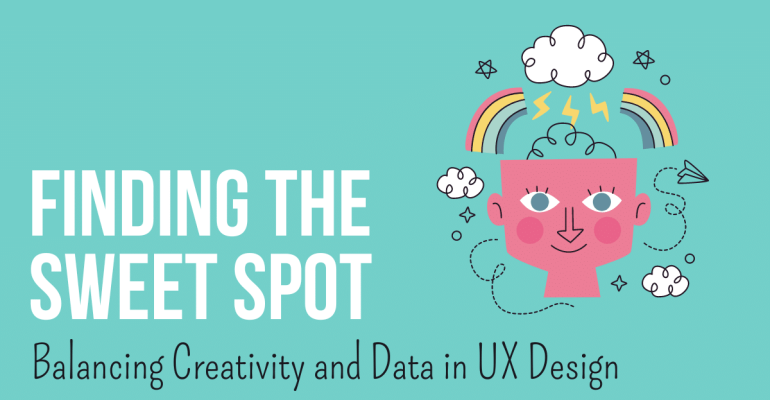Finding the Sweet Spot: Balancing Creativity and Data-Driven Decision-Making in UX Design
7. February 2023 2023-09-28 12:03Finding the Sweet Spot: Balancing Creativity and Data-Driven Decision-Making in UX Design

Finding the Sweet Spot: Balancing Creativity and Data-Driven Decision-Making in UX Design
As UX designers, we’re constantly trying to balance two seemingly opposing forces: creativity and data-driven decision-making. On the one hand, creativity is essential to the design process, bringing new ideas and innovative solutions to the table. On the other hand, data provides the foundation for making informed decisions that result in a positive user experience.
Balancing these two elements can be a tricky task, but it’s also one that’s incredibly important. After all, a design-driven purely by creativity might not always meet user needs, while a solely data-driven strategy can lack personality and appeal.
So, how can you balance creativity and data-driven decision-making in your UX design process? In this article, I’ll explore the role of creativity and data-driven decision-making in UX design, the challenges of balancing these elements, and best practices for finding that sweet spot.
Let’s dive in!
The role of creativity in UX design
Creativity is a critical component of the UX design process. It allows designers to develop innovative solutions, unique perspectives and designs that stand out from the crowd. Of course, there is no such thing as design without creativity. However, let’s have a look at the benefits of incorporating more creative approaches into your UX design process:
- Improving the user experience: A creative approach to design can result in a more enjoyable, memorable, and meaningful user experience.
- Differentiating your product or service: A creative design can help it stand out from the competition, making it more memorable and appealing to users.
- Encouraging exploration and experimentation: By encouraging a creative approach, designers can explore new ideas, try different directions, and ultimately find the best solution for the user.
It’s important to note, however, that creativity in UX design isn’t just about making things look pretty or adding visual flair. It’s about finding innovative ways to solve user problems and meet user needs. A creative UX design solution should always be based on a deep understanding of the user, their needs, and the business goals for the product or service.
The role of data-driven decision-making in UX design
While creativity is essential to the UX design process, data-driven decision-making is just as important. After all, the ultimate goal of UX design is to create a positive user experience, and data can provide the insights needed to inform design decisions that will achieve that goal.
By using data to inform design decisions, UX designers can:
- Make informed decisions: Data provides the facts and insights needed to make sound decisions about the design.
- Improve the user experience: By using data to understand user behaviour and preferences, designers can create a more personalized and practical user experience.
- Optimize design solutions: Data can be used to measure the success of design solutions and make improvements as needed.
It’s worth noting that data-driven decision-making doesn’t mean ignoring creativity or abandoning the design process. Instead, it means using data as a tool to advise and validate design decisions, ultimately resulting in a better user experience.
The challenges of balancing creativity and data-driven decision-making
Balancing creativity and data-driven decision-making in UX design can be challenging, as the two elements often seem at odds with each other. Here are a few of the common challenges designers face when trying to strike a balance:
- Data can constrain creativity: Data can be limiting, dictating certain design decisions that may not align with the designer’s creative vision.
- Creativity can lead to bias: Without data to inform design decisions, designers may rely on their personal preferences and thus fall for their own biases, leading to solutions that may not align with user needs.
- Finding the right balance: Finding the right balance between creativity and data-driven decision-making can be difficult, as too much of one can negatively impact the other.
Despite these challenges, balancing creativity and data-driven decision-making is essential to creating a successful UX design. So, how can you find that balance?
Tips for balancing creativity and data-driven decision-making in UX design
- Start with user research: Before making any design decisions, conduct user research to understand their needs, behaviour, and preferences. This information will inform both your creative approach and your data-driven decisions.
- Use data to validate design solutions: Use facts to authenticate your design solutions and make informed decisions about the design. This can help ensure that your creative solutions align with user needs and business goals.
- Encourage collaboration between designers and data analysts: Encourage collaboration between designers and data analysts to ensure that data is being used effectively to inform design decisions.
- Give yourself time for pure creativity: Set aside dedicated time for pure creative exploration without being limited by data. This will allow you to come up with innovative design solutions and a fresh perspective that can later be validated and informed by data.
- Iterate, iterate, iterate: Don’t be afraid to iterate on your design solutions, using data to inform and validate each iteration. This process will help you find the right balance between creativity and data-driven decision-making.
- Embrace a growth mindset: Be open to new ideas and approaches, and embrace failure as an opportunity to learn and grow. This growth mindset will help you find the balance between creativity and data-driven decision-making in UX design.
Conclusion
Balancing creativity and data-driven decision-making in UX design can be demanding, but it’s essential to creating a successful user experience. Using user research to inform design decisions, collaborating between designers and data analysts, iterating on design solutions, allowing room for creativity, and embracing a growth mindset, designers can find the right balance and create effective, user-centred design solutions.
In conclusion, the key to balancing creativity and data-driven decision-making in UX design is to use data as a tool to inform and validate design decisions, not as a constraint on creativity. By finding the right balance, UX and product designers can create effective, user-centred design solutions that meet both business goals and user needs.
Recommended Reading
Weinschenk, S. (2018). What Is The Role Of Creativity In UX Design? Smashing Magazine. https://www.smashingmagazine.com/2018/12/role-of-creativity-ux-design/
Goldberg, D. (2019). Data-Driven Design: What It Is and Why It Matters. Springboard. https://www.springboard.com/blog/design/data-driven-design/







